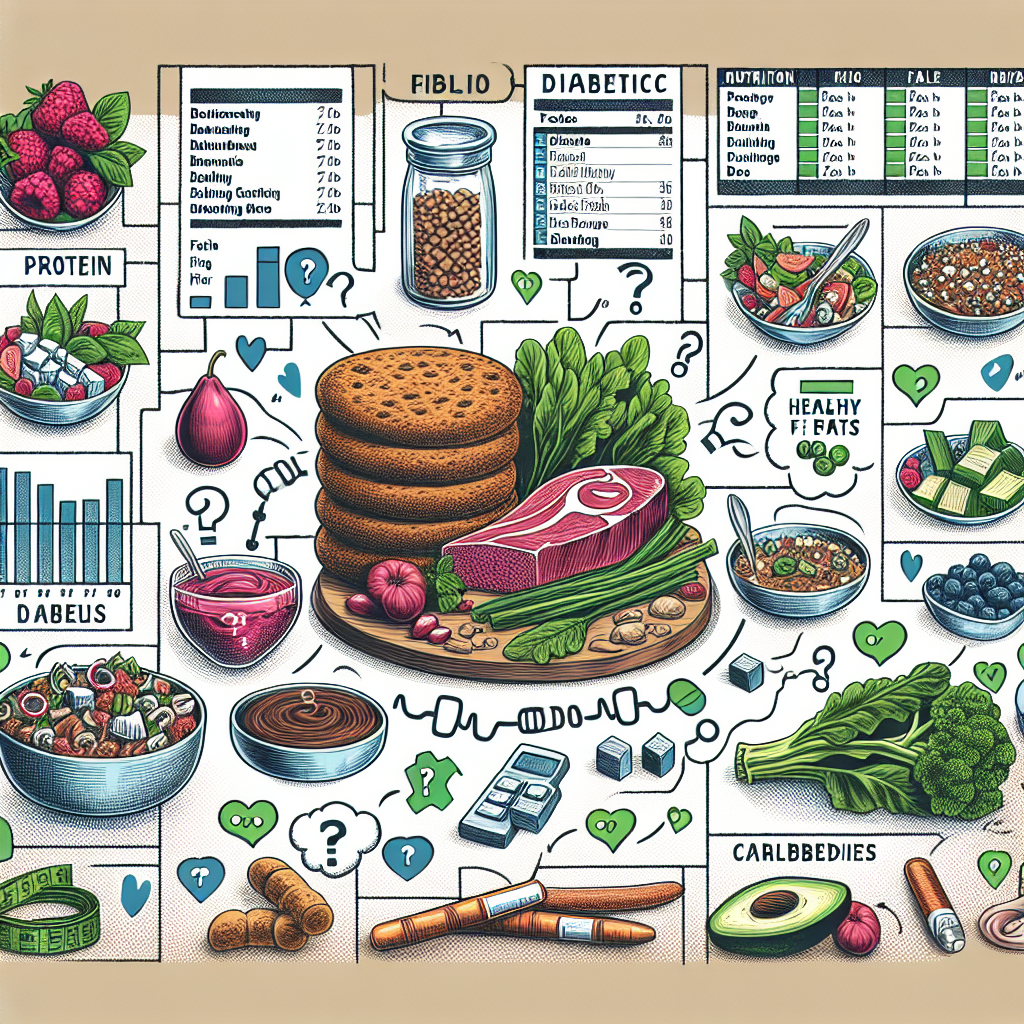Are you a diabetic vegan looking to maintain a balanced and nutritious diet? Striking a fine balance between managing your blood sugar levels and meeting your nutritional needs might seem challenging, but it is certainly achievable. In this article, we will explore effective strategies and key considerations that can help you ensure a nutritional balance in your diabetic vegan meal plan. By making mindful choices and incorporating a variety of nutrient-rich foods, you can nourish your body while keeping your health goals in check.

Understanding Diabetic Vegan Meal Plan
What is a diabetic vegan meal plan?
A diabetic vegan meal plan is a dietary approach that combines the principles of veganism and diabetes management. It involves consuming plant-based foods while focusing on maintaining stable blood sugar levels. This meal plan eliminates all animal products, including meat, dairy, and eggs, and instead emphasizes fruits, vegetables, whole grains, legumes, and plant-based proteins.
Why is nutritional balance important in a diabetic vegan meal plan?
Nutritional balance is crucial in a diabetic vegan meal plan because it helps control blood sugar levels, manage weight, and promote overall health. By consuming a variety of plant-based foods, individuals can ensure they receive all the essential nutrients their bodies need. Proper nutrition also helps prevent nutrient deficiencies, reduces the risk of chronic diseases, and supports optimal functioning of the body.
Considerations for a Diabetic Vegan Meal Plan
Consulting a healthcare professional
Before embarking on a diabetic vegan meal plan, it is essential to consult a healthcare professional, such as a registered dietitian or nutritionist, who specializes in vegan and diabetic diets. They can provide personalized advice, develop a meal plan tailored to individual needs, and provide ongoing support and guidance throughout the journey. This ensures that the meal plan is safe, effective, and sustainable for managing diabetes while meeting all nutritional requirements.
Monitoring blood sugar levels regularly
Regularly monitoring blood sugar levels is crucial in a diabetic vegan meal plan to ensure that the dietary choices are effectively managing diabetes. This can be done using a glucose meter, which measures blood sugar levels at different times of the day. By tracking blood sugar readings, individuals can make informed decisions regarding their food choices, portion sizes, and the timing of their meals and snacks.
Macronutrient Balance in a Diabetic Vegan Meal Plan
Importance of macronutrients in a balanced meal plan
Macronutrients, including carbohydrates, proteins, and fats, are the three main components of a balanced meal plan. Each macronutrient plays a significant role in the body and is essential for maintaining good health. In a diabetic vegan meal plan, ensuring the right balance of macronutrients is crucial for managing blood sugar levels, promoting satiety, and providing the body with the necessary energy and nutrients it needs to function optimally.
Calculating the right balance of carbohydrates, proteins, and fats
Calculating the right balance of carbohydrates, proteins, and fats in a diabetic vegan meal plan can vary depending on an individual’s specific needs and goals. Generally, it is recommended to consume a moderate amount of carbohydrates from whole grains, fruits, and vegetables, focusing on low glycemic index (GI) foods. Protein sources can come from plant-based options such as legumes, tofu, tempeh, and seitan. Healthy fats, such as those found in avocados, nuts, seeds, and olive oil, should be included in the diet in moderation.
Diabetic-Friendly Carbohydrate Sources
Choosing low glycemic index (GI) foods
In a diabetic vegan meal plan, choosing low glycemic index (GI) foods is essential for maintaining stable blood sugar levels. Low GI foods have a slower impact on blood glucose levels, preventing spikes and crashes. Examples of low GI foods include whole grains, such as oats, quinoa, and brown rice, as well as non-starchy vegetables like broccoli, spinach, and cauliflower. These foods provide sustained energy, fiber, and various essential nutrients without causing drastic fluctuations in blood sugar.
Including whole grains and legumes for fiber
Including whole grains and legumes in a diabetic vegan meal plan is beneficial due to their high fiber content. Fiber contributes to better blood sugar control by slowing down the absorption of glucose and promoting a feeling of fullness. Whole grains like bulgur, barley, and whole wheat bread provide complex carbohydrates and fiber. Legumes, such as lentils, chickpeas, and black beans, are excellent plant-based protein sources that also contribute to fiber intake. These foods enhance satiety, aid digestion, and support overall health.

Plant-Based Protein Sources in a Diabetic Vegan Meal Plan
Selecting high-quality plant proteins
Selecting high-quality plant proteins is important in a diabetic vegan meal plan to maintain muscle mass, support cell repair, and provide essential amino acids. High-quality plant protein sources include tofu, tempeh, edamame, seitan, and soy products, which offer a complete amino acid profile. Other options like legumes (lentils, beans, peas), nuts, seeds, and quinoa also provide valuable protein and can be incorporated into meals and snacks for variety.
Combining different protein sources for a complete amino acid profile
To ensure a complete amino acid profile, it is beneficial to combine different plant protein sources in a diabetic vegan meal plan. By combining complementary plant proteins, such as legumes and grains (e.g., rice and beans), individuals can obtain all the essential amino acids their bodies need. This approach ensures that the body can build and repair tissues, promote healthy immune function, and support various physiological processes.
Healthy Fats in a Diabetic Vegan Meal Plan
Choosing unsaturated fats over saturated fats
Choosing unsaturated fats over saturated fats is important in a diabetic vegan meal plan to support heart health and manage blood cholesterol levels. Unsaturated fats, found in foods such as avocados, nuts, seeds, and olives, provide essential fatty acids and have been associated with a reduced risk of cardiovascular diseases. They should be included in moderation, replacing saturated fats found in animal products and processed foods, which can increase inflammation and contribute to insulin resistance.
Including omega-3 fatty acids for heart health
Including omega-3 fatty acids in a diabetic vegan meal plan is beneficial for promoting heart health and reducing inflammation. Plant-based sources of omega-3 fatty acids include flaxseeds, chia seeds, hemp seeds, and walnuts. These foods provide alpha-linolenic acid (ALA), a form of omega-3 that can be converted to eicosapentaenoic acid (EPA) and docosahexaenoic acid (DHA) in the body. Alternatively, algal oil supplements derived from marine algae can be considered to ensure an adequate intake of EPA and DHA.

Micronutrients in a Diabetic Vegan Meal Plan
Importance of vitamins and minerals for overall health
In a diabetic vegan meal plan, obtaining an adequate intake of vitamins and minerals is crucial for overall health and wellbeing. Incorporating a variety of nutrient-dense fruits and vegetables is key to ensure a wide range of essential vitamins and minerals. Leafy green vegetables, berries, citrus fruits, cruciferous vegetables, and colorful produce contain vitamins A, C, E, as well as minerals like magnesium, potassium, and calcium. These micronutrients support various bodily functions, strengthen the immune system, and reduce the risk of chronic diseases.
Choosing nutrient-dense fruits and vegetables
When planning a diabetic vegan meal, it is essential to choose nutrient-dense fruits and vegetables. Nutrient density refers to the amount of vitamins, minerals, and other beneficial compounds present in a particular food compared to its calorie content. Opt for colorful berries, leafy greens, cruciferous vegetables, citrus fruits, and other whole plant foods that offer a wide array of vitamins, minerals, and antioxidants. These foods provide essential nutrients without excessive calories or unwanted sugar.
Avoiding Processed Foods and Added Sugars
Understanding the impact of processed foods on blood sugar control
Avoiding processed foods is crucial in a diabetic vegan meal plan because they often contain added sugars, unhealthy fats, and refined carbohydrates. These processed foods can cause dramatic spikes in blood sugar levels and may lead to weight gain, poor glycemic control, and increased risk of complications associated with diabetes. Instead, focus on whole, unprocessed plant-based foods that provide a good balance of nutrients and contribute to stable blood sugar levels.
Opting for natural sweeteners or sugar substitutes
When a touch of sweetness is desired in a diabetic vegan meal plan, it is best to opt for natural sweeteners or sugar substitutes that have a lower impact on blood sugar levels. Examples include stevia, monk fruit extract, erythritol, and small amounts of maple syrup or coconut sugar. These alternatives provide a sweet taste without the rapid rise in blood sugar associated with refined sugars. It is important to use them in moderation and be mindful of the overall carbohydrate content of the meal.

Timing and Portion Control
Spreading meals and snacks throughout the day
Timing and portion control are essential aspects of a diabetic vegan meal plan. Spreading meals and snacks throughout the day helps maintain stable blood sugar levels and prevents extreme hunger or overeating. Aim for three balanced meals and two or three snacks, depending on individual needs. By spacing out food intake, individuals can avoid long periods without eating, which can result in blood sugar fluctuations and increased appetite.
Monitoring portion sizes for better glycemic control
Monitoring portion sizes is key to achieving better glycemic control in a diabetic vegan meal plan. Paying attention to the amount of food consumed helps maintain a healthy weight and prevents blood sugar spikes. Using measuring cups, food scales, or visual cues can help ensure appropriate portion sizes. Additionally, being mindful of the carbohydrate content of meals allows for better calculation of insulin or medication requirements, if necessary.
Regular Monitoring and Adjustments
Monitoring blood sugar levels and adjusting the meal plan accordingly
Regularly monitoring blood sugar levels is crucial in a diabetic vegan meal plan to assess the impact of dietary choices on glycemic control. By tracking blood sugar levels before and after meals, individuals can identify patterns and make adjustments to their meal plan as necessary. If blood sugar levels consistently exceed or fall below the target range, consulting with a healthcare professional is recommended to modify the meal plan and ensure optimal diabetes management.
Consulting a healthcare professional for guidance
Throughout the journey of a diabetic vegan meal plan, it is important to consult a healthcare professional regularly for guidance and support. Seeking professional advice allows for personalized recommendations, adjustments to the meal plan, and monitoring of overall health progress. Healthcare professionals can also provide information on the latest research, advancements in diabetes management, and help address any concerns or challenges experienced along the way. Their expertise ensures the meal plan is optimized for individual needs and contributes to long-term success in managing diabetes in a vegan lifestyle.


